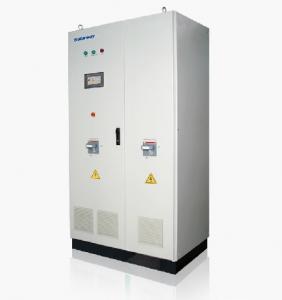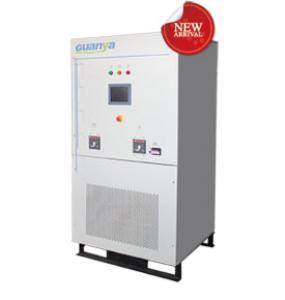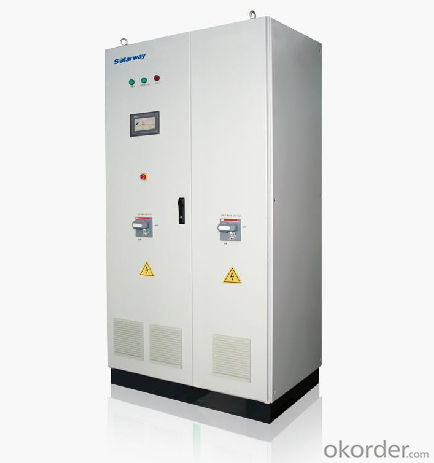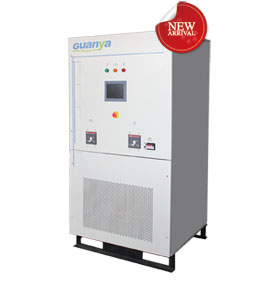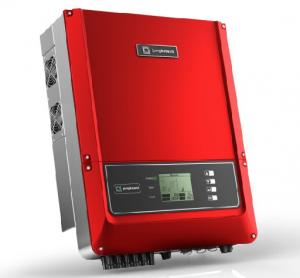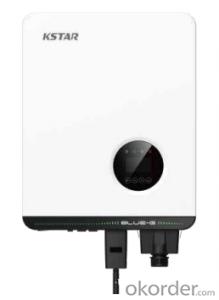500 Watt PV On-Grid Inverter GSG-100KTV from China
OKorder Service Pledge
OKorder Financial Service
You Might Also Like
Description:
CNBMSOLAR is a world-leading and Vertical integrated manufacturer of high-performance with Silicon,
Wafer, Cells, Modules, which convert sunlight into electricity for residential, commercial, and utility-scale
power generation.
The capacity of CNBMSOLAR is reach to 1GW, and make sure each year our shipment capacity is more
Than 700-800MWs, at the same time, we have set up the largest solar power station with our partner
in Ukraine.
CNBM is a Quality + Service oriented company with“Excellence at Each Step” approach, composed of
the finest components from TUV and IEC-certified partners around the world, CNBM modules consistently
undergo a variety of trials at the company’s Test & Development Centre, ensuring peak performance
capabilities. The company is committed to develop and provide the world with clean and renewable energy
to ease the energy shortages as well as human kind’s impact on the environment.
Data:
Isolation mode | Transformer inside | Max. Input voltage(VDC) | 1000 |
Max. DC. Input power(KW) | 125 | Max. PV parallel module number | —— |
Max. Input current(A) | 250 | MPPT range(VDC) | 440~850 |
Recommend PV module power(VDC) | 720 | Rated Grid frequency(Hz) | 50 |
Rated AC output power(KW) | 110 | Euro efficiency | 96.50% |
Rated Grid voltage and allowed range(VAC) | 400/310~450 | THD | <3% |
Max efficiency | 97.20% | MPPT Precision | 99% |
Display | Touch screen | Electromagnetic compatibility | IEC61000-6-1/-2/-3/-4 |
Power factor | ≥0.99 | Grid detection | DIN VDE 0126-1-1-2010 |
Overload operating | Automatically adjust the running peak | Grid disruption | IEC61000-3-2/-3 |
Communication interface | RS485 | Internal consumption at night(W) | <50 |
DC voltage ripple | Vpp < 10% | Protection class | IP20(indoor) |
Anti-islanding protection | Vac;Fac | Ground fault monitoring protection | Yes |
Grid monitoring protection | Yes | DC reverse-polarity protection | Yes |
AC short-circuit capacity protection | Yes | DC switch protection | Yes |
Noisy(dB) | <30 | Cooling concept | Forced air cooling |
Operating temperature range(℃) | -20~55(>50℃drop) | Operating humid range | 0~95%(non-condensing) |
Dimensions(dxwxh mm) | 800×1000×1940 | Weight(Kg) | 1022 |
Altitude(m) | 6000(>3000m start to drop) |

FAQ:Could you pls introduce more about CNBM?
CNBM Group is short for China National Building Materials Group Corporation, which is established in 1984 with approval from the State Council
CNBM Group is the largest comprehensive building materials industry group in China
The Group has a total asset of over RMB 360 billion, more than 180,000 employees and 17 subsidiaries
- Q: What is the role of anti-islanding protection in a solar inverter?
- The role of anti-islanding protection in a solar inverter is to ensure the safety of electrical grid workers by preventing the solar inverter from energizing the grid during a power outage. It is designed to detect grid failures and immediately disconnect the solar system from the grid, avoiding a potentially dangerous situation known as islanding. This protection feature helps maintain the stability and integrity of the electrical grid and protects both the grid workers and the solar system itself.
- Q: Can a solar inverter be used in areas with high dust and dirt accumulation?
- Yes, a solar inverter can be used in areas with high dust and dirt accumulation. However, it is important to regularly clean and maintain the inverter to prevent any performance issues caused by the accumulation of dust and dirt.
- Q: What is the role of reactive power control in a solar inverter?
- The role of reactive power control in a solar inverter is to maintain the power factor of the system by managing the flow of reactive power. This helps to improve the overall efficiency and stability of the solar power generation system. Reactive power control ensures that the inverter can supply or absorb the necessary reactive power to balance the system, compensate for reactive power losses, and meet the grid requirements.
- Q: What is the role of a solar inverter in reactive power compensation?
- To regulate and control the flow of reactive power in a solar power system, a solar inverter plays a crucial role in reactive power compensation. The presence of inductive or capacitive elements in the system causes reactive power to oscillate between the source and load. Although this power does not contribute to the actual work done by the system, it is necessary for the operation of specific devices. A solar inverter, specifically designed for reactive power compensation, is capable of measuring the reactive power in the system and adjusting its operation accordingly. It has the ability to generate or absorb reactive power as needed to maintain a power factor close to unity. The power factor is a measure of the efficiency of electrical energy utilization, and a high power factor indicates efficient electricity usage. By compensating for reactive power, a solar inverter ensures that the solar power system operates at optimal efficiency. It alleviates the burden on the grid by locally supplying or absorbing reactive power instead of relying on the grid for compensation. This not only improves the overall quality of power but also reduces system losses. Furthermore, it helps stabilize voltage levels and minimize voltage fluctuations, which can be advantageous for delicate electrical equipment. In conclusion, the role of a solar inverter in reactive power compensation is vital for regulating the flow of reactive power in a solar power system, maintaining a high power factor, and improving overall system efficiency. It plays a pivotal role in ensuring the optimal operation of the solar power system and diminishing the dependence on the grid for reactive power compensation.
- Q: What is maximum power point tracking (MPPT) in a solar inverter?
- Maximum power point tracking (MPPT) is a technique used in solar inverters to optimize the power output of a photovoltaic (PV) system. Solar panels generate electricity when exposed to sunlight, and their power output varies depending on factors such as temperature, shading, and the angle of incidence of sunlight. The maximum power point (MPP) is the point at which a solar panel generates the maximum amount of power for a given set of environmental conditions. However, since these conditions are constantly changing, it is essential to continuously track the MPP to ensure the highest possible power output from the solar panels. A solar inverter with MPPT functionality utilizes advanced algorithms and electronics to continuously monitor the voltage and current output of the solar panels. By dynamically adjusting the operating voltage and current to match the MPP, the MPPT inverter ensures that the solar panels operate at their highest efficiency, regardless of the changing environmental conditions. When the solar panels are operating at their MPP, the MPPT inverter extracts the maximum amount of power from the panels and converts it into usable AC power. This optimization leads to higher overall energy generation and maximizes the return on investment for solar power systems. In addition to improving efficiency, MPPT also offers other advantages. It can compensate for fluctuations in solar irradiation, temperature, or shading that may affect the power output of the panels. By continuously tracking the MPP, the MPPT inverter adjusts the operating parameters to mitigate the impact of these factors, ensuring a consistent and optimal power output. Overall, MPPT is a crucial feature in solar inverters as it maximizes the power output of a PV system by continuously tracking and adjusting the operating parameters to match the MPP. This technology enables solar power systems to operate at their highest efficiency, enhance energy generation, and maximize the benefits of utilizing renewable energy sources.
- Q: What are the safety features in a solar inverter?
- Some of the safety features in a solar inverter include over-voltage protection, under-voltage protection, over-current protection, short-circuit protection, and ground-fault protection. Additionally, many modern inverters also have built-in monitoring systems that can detect and alert users to any potential issues or malfunctions.
- Q: How does a solar inverter handle voltage fluctuation during cloud cover?
- A solar inverter handles voltage fluctuation during cloud cover by continuously monitoring and adjusting the output voltage to compensate for the reduced solar energy input. This is typically achieved through advanced control algorithms that optimize the inverter's power output to maintain a stable voltage level, ensuring a smooth transition during periods of cloud cover and minimizing any disruptions to the electrical system.
- Q: What is the role of a solar inverter in a solar-powered telecommunications system?
- The role of a solar inverter in a solar-powered telecommunications system is to convert the direct current (DC) produced by the solar panels into alternating current (AC) that can be used to power the telecommunications equipment. It also ensures that the AC power is stable and at the necessary voltage and frequency for the proper functioning of the system.
- Q: Can a solar inverter be used with a three-phase electrical system?
- Yes, a solar inverter can be used with a three-phase electrical system. In fact, many commercial and industrial solar installations use three-phase inverters to convert the direct current (DC) power generated by solar panels into alternating current (AC) power that can be used by the electrical grid. This allows for efficient power conversion and distribution in three-phase systems, which are commonly used in larger electrical installations.
- Q: How does shading affect the performance of a solar inverter?
- Shading can significantly impact the performance of a solar inverter as it reduces the amount of sunlight reaching the solar panels. This leads to lower energy production and decreased efficiency of the inverter. Shading can cause imbalances in the overall system, resulting in reduced power output and potential overheating of the inverter. Additionally, shading can lead to the activation of safety mechanisms within the inverter, such as Maximum Power Point Tracking (MPPT) algorithms, which further decrease its performance. Therefore, avoiding shading or implementing shading mitigation techniques is crucial for maximizing the performance of a solar inverter.
Send your message to us
500 Watt PV On-Grid Inverter GSG-100KTV from China
OKorder Service Pledge
OKorder Financial Service
Similar products
Hot products
Hot Searches
Related keywords
